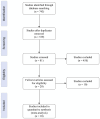Meta-analysis of the synergistic effect of magnetic resonance imaging and mammography in breast cancer detection in women with dense breasts
- PMID: 40226002
- PMCID: PMC11982899
- DOI: 10.62347/BMWY7899
Meta-analysis of the synergistic effect of magnetic resonance imaging and mammography in breast cancer detection in women with dense breasts
Abstract
Objectives: This meta-analysis aimed to evaluate the combined effectiveness of Magnetic Resonance Imaging (MRI) and mammography in detecting breast cancer in women with dense breasts.
Methods: A comprehensive search was conducted across PubMed, Web of Science, and EMBASE databases up to December 31, 2023, to identify relevant studies. Studies focusing on breast cancer detection in women with dense breast tissue and providing data on the sensitivity, specificity, or positive predictive value of combined MRI and mammography screening, or the use of MRI following a negative mammogram, were included. The meta-analysis was conducted using Stata 15.0, and study quality was assessed using the Quality Assessment of Diagnostic Accuracy Studies-2 (QUADAS-2) tool.
Results: Ten studies, involving 51,602 participants, were included in the meta-analysis. The combined use of MRI and mammography for breast cancer detection in women with dense breasts yielded a pooled sensitivity of 0.87 (95% CI: 0.79-0.92), specificity of 0.95 (95% CI: 0.89-0.97), positive likelihood ratio of 2.55 (95% CI: 1.45-4.46), negative likelihood ratio of 0.11 (95% CI: 0.07-0.17), diagnostic score of 3.18 (95% CI: 2.35-4.02), and diagnostic ratio of 24.14 (95% CI: 10.44-55.81), and an area under the Summary Receiver Operating Characteristic curve of 0.97 (95% CI: 0.95-0.98).
Conclusion: This meta-analysis demonstrated that the combination of MRI and mammography enhanced breast cancer detection in women with dense breasts. This synergistic approach significantly improves detection sensitivity in this high-risk group.
Keywords: Breast cancer; Magnetic Resonance Imaging (MRI); dense breast tissue; mammography; meta-analysis.
AJTR Copyright © 2025.
Conflict of interest statement
None.
Figures








Similar articles
-
Supplemental Screening as an Adjunct to Mammography for Breast Cancer Screening in People With Dense Breasts: A Health Technology Assessment.Ont Health Technol Assess Ser. 2023 Dec 19;23(9):1-293. eCollection 2023. Ont Health Technol Assess Ser. 2023. PMID: 39364436 Free PMC article.
-
Diagnostic Performance of Adjunctive Imaging Modalities Compared to Mammography Alone in Women with Non-Dense and Dense Breasts: A Systematic Review and Meta-Analysis.Clin Breast Cancer. 2021 Aug;21(4):278-291. doi: 10.1016/j.clbc.2021.03.006. Epub 2021 Mar 16. Clin Breast Cancer. 2021. PMID: 33846098
-
Cancer screening with digital mammography for women at average risk for breast cancer, magnetic resonance imaging (MRI) for women at high risk: an evidence-based analysis.Ont Health Technol Assess Ser. 2010;10(3):1-55. Epub 2010 Mar 1. Ont Health Technol Assess Ser. 2010. PMID: 23074406 Free PMC article.
-
Supplemental Breast Cancer Screening in Women with Dense Breasts and Negative Mammography: A Systematic Review and Meta-Analysis.Radiology. 2023 Mar;306(3):e221785. doi: 10.1148/radiol.221785. Epub 2023 Jan 31. Radiology. 2023. PMID: 36719288
-
Role of Supplemental Breast MRI in Screening Women with Mammographically Dense Breasts: A Systematic Review and Meta-analysis.J Breast Imaging. 2024 Jul 30;6(4):355-377. doi: 10.1093/jbi/wbae019. J Breast Imaging. 2024. PMID: 38912622
References
-
- Tzeng YT, Hsiao JH, Tseng LM, Hou MF, Li CJ. Breast cancer organoids derived from patients: a platform for tailored drug screening. Biochem Pharmacol. 2023;217:115803. - PubMed
-
- Upadhyay N, Wolska J. Imaging the dense breast. J Surg Oncol. 2024;130:29–35. - PubMed
-
- Farkas AH, Nattinger AB. Breast cancer screening and prevention. Ann Intern Med. 2023;176:ITC161–ITC176. - PubMed
-
- Kwon MR, Chang Y, Ham SY, Cho Y, Kim EY, Kang J, Park EK, Kim KH, Kim M, Kim TS, Lee H, Kwon R, Lim GY, Choi HR, Choi J, Kook SH, Ryu S. Screening mammography performance according to breast density: a comparison between radiologists versus standalone intelligence detection. Breast Cancer Res. 2024;26:68. - PMC - PubMed
Publication types
LinkOut - more resources
Full Text Sources
